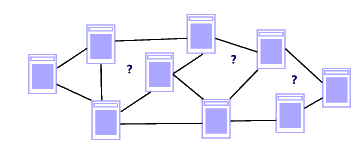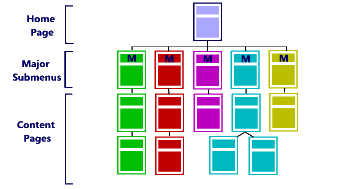| Website structure |
| "Man is the great pattern-maker
and pattern perceiver. No matter how primitive his situation, no
matter how tormented, he cannot live in a world of chaos." Edmund Carpente Packaging your information refers to dividing it logically into small and manageable sections. Structuring your information means deciding how bits of information link to each other. Structuring your informationStructure is very important, because it helps the reader to identify how your information is organized. A confusing structure is going to mean that much of the information on your site is never found or read. In Structure A below, the reader is confused by not knowing where the main menu (M) is, or how it relates to specific documents.
Structure A On the other hand, Structure B (below) has one main home page which is linked to 7 sub-menus, each with its own related documents.
Structure B You are identifying these sub-menus in this activity as you plan your content online. Users of your website will be able to identify with this kind of structure and will be more comfortable finding their way around this site. Where possible you should avoid creating "sub-sub-menus" i.e. another menu page after the sub-menu page. Look at the SA township life for teenagers site and navigate between the documents. What are the major problems with this structure? What recommendations would you make to improve the site? As you have discovered, structure is closely related to the ability to navigate (find your way) through the information. To ensure that your website structure will be easy to follow, try to put yourself in the position of your readers. Think about what would make them comfortable using your site. You might even try to get some input from potential users to help with this process.
|

